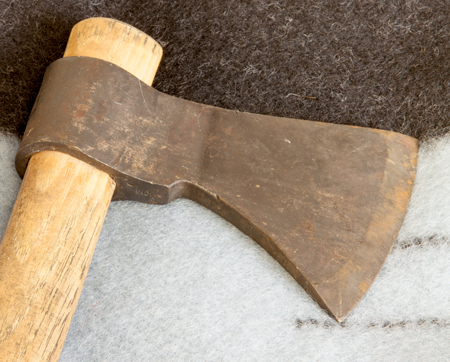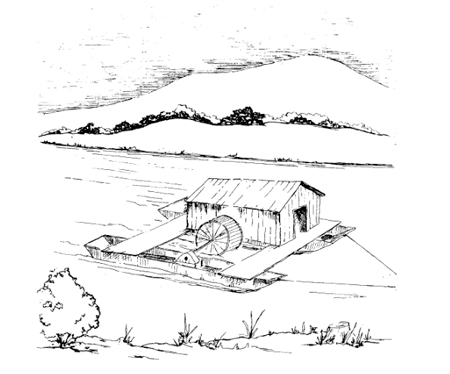Millwood, WV On the advice of the barge captain, Lewis heads down the Ohio before the morning fog has cleared. They stop on a sandbar opposite Oldtown Creek to dry the wet cargo. Lewis has the rusted goods such as iron tomahawks and guns oiled.
Rusty Tomahawk
© 2013 Kristopher K. Townsend. Permission to use granted under the Creative Commons Attribution-Share Alike 4.0 International license.
At this point in the journey, the tomahawks would only include the heads. The handles could be made and added as needed.
Drying Out
I determined to spend the day and to open & dry my goods which I had found were wet by the rain on the 15th notwithstanding . . . . I found on opening the goods that many of the articles were much Injured; particularly the articles of iron, which wer rusted very much my guns, tomehawks, & knives were of this class; I caused them to be oiled and exposed to the sun the clothing of every discription also was opened and aired, we busily employed in this business all hands
—Meriwether Lewis
Upstream Winds
between the riffles and in many places for several miles together there is no preseptable courent, the whole surface being perfectly dead or taking the direction only which the wind may chance to give it, this makes the passage down this stream more difficult than would at first view be immageoned, when it is remembered also that the wind so frequently sets up the river the way the traveler makes in descending therefore is by the dint of hard rowing—or force of the oar or pole.
—Meriwether Lewis
Floating Mill
When passing this same stretch of river just a few days behind Lewis, Rodney mentions a floating mill between the Little Sandy and Ravenswood:
[W]e passed a floating mill anchored in the river. She was placed on a flat or scow and a canoe without it for the axes of the water wheel to lodge on; and both were connected and held together by a frame of square logs above and below.
—Thomas Rodney[1]26 September 1803. Dwight L. Smith and Ray Swick, ed., A Journey Through the West: Thomas Rodney’s 1803 Journal from Delaware to the Mississippi Territory (Athens: Ohio University Press, 1997), … Continue reading
Griffin Greene, who helped establish Marietta, had seen floating mills in France and Holland, and thought they could solve the problem of pioneers unable to safely reach mills during the Indian war of 1791. Captain Jonathan Devoll, when given their description, constructed such a mill. Besides the Ohio, they were known to be on the Little Miami, Scioto, Hocking, and Muskingum Rivers.[2]International Society for Landscaping, Place & Material Culture. “Cruising Down the River . . . in a Gristmill.” Pioneer America (1980), 115.
Notes
| ↑1 | 26 September 1803. Dwight L. Smith and Ray Swick, ed., A Journey Through the West: Thomas Rodney’s 1803 Journal from Delaware to the Mississippi Territory (Athens: Ohio University Press, 1997), 76. |
|---|---|
| ↑2 | International Society for Landscaping, Place & Material Culture. “Cruising Down the River . . . in a Gristmill.” Pioneer America (1980), 115. |


